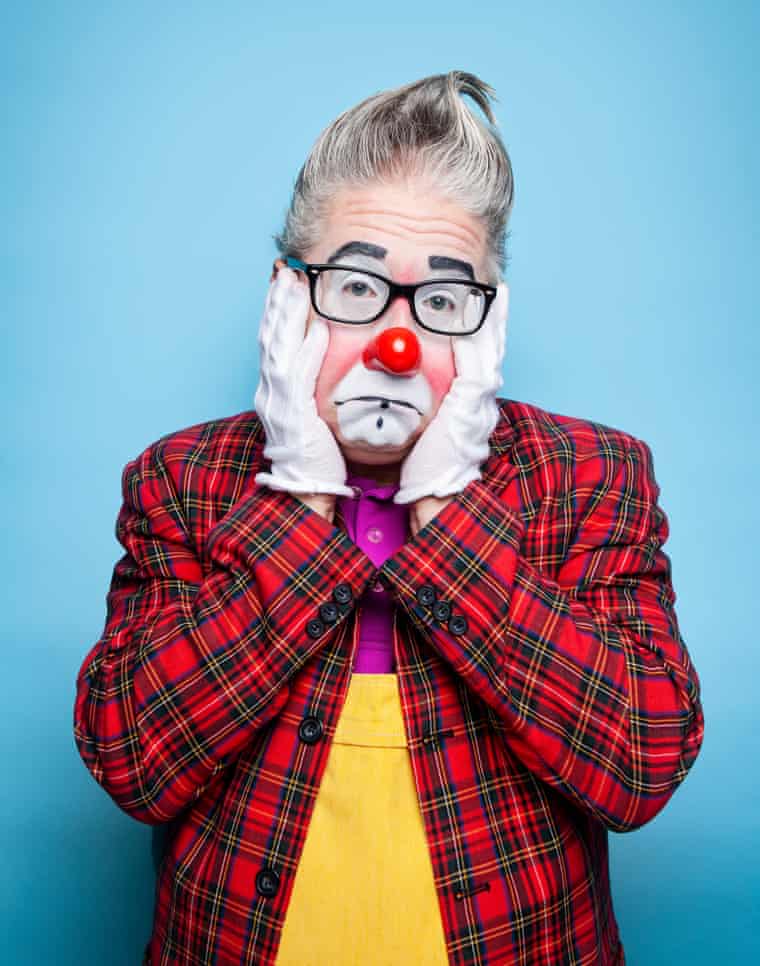SALOUMEH FARAHDIAN ARTNEWSPRESS: The massive popularity of horror films like Joker and It have been a real downer for happy, family clowns. Mark Wilding hears how the entertainers are fighting back
In the corner of Matthew Indge’s kitchen is a photograph of the entertainer Kerby Drill. For many years, Drill was both a clown and a comic voice of authority. He toured the nation’s schools and appeared on television shows, often promoting road safety, until he passed away last year, aged 97. Indge describes him as his “clown hero”, but he recognises that Drill represents a very different era of clowning. “The truth is,” Indge says, “these days, I don’t know if kids are going to listen to a clown saying be careful on the road.”
Indge has been clowning for 32 years, since he was eight years old. In a way that wasn’t necessary for Drill, Indge must now take steps to prove to his audiences that he doesn’t represent a dark and sinister threat. When we meet, he’s preparing for a performance as Zaz the Clown at a five-year-old’s birthday party, and “just to save me any problems,” he says, “I’ll make up in front of the kids” – an attempt to provide reassurance that there’s a benign performer behind the mask.
As I sip tea from a mug printed with a photo of Indge dressed as an ostrich performing in front of a crowd of delighted children, he recalls how, as a child himself, he would borrow his father’s shirts, cover them with badges, and join hundreds of other clowns for a triumphant annual convention and parade through Bognor Regis, his home town.

More than 850 people attended the event in 1991, setting a world record for the largest gathering of professional clowns. More recently the parade has taken place only intermittently, but its glory years were instrumental in shaping Indge’s view of clowning as an art form with near universal appeal. “I still firmly believe that now,” he says. “I’ve entertained kids in the Ritz and kids on a rough estate in Brixton – on the same day. Same day, same act, very different people.”
Indge has performed for all kinds of audiences over the years. He tells me about gigs in airport terminals, at funerals and at a 21st birthday party in London’s Fabric nightclub. Nowadays, he largely tours schools with his Circus Pazaz show. Wherever the performance might be, he tries to capture the innocent spirit of the clowns he was inspired by as a boy, which means actively avoiding the sinister side of clowning. “I don’t really – excuse the pun – entertain that sort of genre at all,” he says. “I haven’t seen any of those scary movies.”
The movies he’s talking about include Joker, this year’s box-office hit. It tells the story of Arthur Fleck as he gradually transforms into a comic-book super villain, a process that culminates in a murderous rampage. The film plays on all our worst suspicions about clowns: that a sinister and unpredictable character lies behind the mask. In November it became the highest grossing comic-book film of all time.
Joker’s UK release came just a month after It Chapter 2 arrived in cinemas, itself released two years after the first big-screen appearance of Stephen King’s creation, the murderous clown Pennywise.

The recent box-office success of sinister clowns marks the peak of a process that began in earnest in 1990, when a television adaptation of It was first broadcast in the US. Since then, creepy clowns have gradually edged good clowns out of the public’s consciousness. In a 2014 YouGov poll, 12% of British adults said they were either “very afraid” or “a little afraid” of clowns. Two years later, coulrophobia – a term coined in the 1980s to denote a fear of clowns – was shortlisted by the Oxford English Dictionary for its word of the year (facing stiff competition from “Brexiteer”, “alt-right”, and “woke”; the winner was “post-truth”).
In his 2016 book Bad Clowns, Benjamin Radford writes: “It’s misleading to ask when clowns turned bad, for they were never really good.” Radford asserts that clowns and jesters have been ambiguous characters for hundreds of years. But he adds that the clowns of our nightmares have “flourished and found fame” in the past few decades. Clowns, as with everything else in modern life, have become polarised, leaving audiences unsure how to react to a performer in white face paint. As Radford writes: “You can no more separate a good clown from a bad clown than a clown from his shadow.” So where does this leave our well-intended red-nosed comedians?
A police siren screams before a voice announces over a loudhailer: “Hello, hello, hello.” The speaker crackles. “PC Bibbledy Bob here.” Rob Bowker beams, then lowers the mouthpiece. He points to a yellow sticker attached to the bonnet of the miniature patrol vehicle parked outside his house in Tamworth. “I’ve even given myself a ticket,” he says. “Firm but fair; I was on double yellows.” Next to us is Bowker’s 13-year-old daughter, Millie, who made her professional clowning debut this summer. She sits in the driving seat of a red and yellow clown car. “I don’t get tickets,” she declares defiantly. “I take them off.”
The jokes come frequently with Bowker. But, recently, he’s been forced to get serious. In October 2016, clowns were in the headlines for all the wrong reasons. A “killer clown” craze was sweeping the UK and the US. Individuals wearing clown masks were taking to the streets, terrorising children. As spokesperson for the Clowns International membership organisation, Bowker fielded calls from the nation’s media. He warned that the craze was putting livelihoods at risk, and he expressed hope that he and his colleagues would soon be allowed to get back to funny business. In a column for the Guardian, he wrote: “In three weeks’ time Halloween will be over and I’m hopeful that the media frenzy will have moved on, leaving genuine clowns to do what we do best.”
Today, Bowker plays down the extent to which the creepy clown phenomenon has affected family entertainers. “I think the public are actually crystal clear that it’s two separate things,” he says. But, occasionally, there are awkward moments, when the line between good and bad clowns becomes blurred. Bowker was recently booked to attend an event for a beer brand, but when he arrived he was asked to appear alongside burlesque performers. “There were people shooting nails through their nose and stuff like that,” he says, recalling the incident with astonishment. “We were like: ‘I think there’s a miscommunication here. We’re family, happy clowns.’ ”

Andrew Davis was booked to perform alongside Bowker that day. When I arrive in Norwich to meet Davis, I am greeted by a man with white face paint and a red nose, wearing an orange bowler hat, white gloves and oversized shoes. Next to him, a battered brown briefcase rests upon a fully extended ironing board. As we stroll together through the city centre, Davis still clutching the briefcase and ironing board, he shouts a cheery hello to anyone who glances his way. Some people smile; most don’t bat an eyelid. No one seems particularly scared.
Earlier this year, he became president of the World Clown Association. In March, his inaugural president’s message appeared in Clowning Around magazine. “The last few years haven’t been the easiest of rides,” he wrote, “but we can leave all that behind us and concentrate on the future.” When we speak, Davis pinpoints the start of clowning’s recent troubles to the television adaptation of Stephen King’s It. “A bit of a bad press,” he remarks with understatement. More than two decades later, in 2013, King’s Pennywise made a series of mysterious appearances in Northampton, in what was later revealed to be a university student’s prank. Davis recalls the time with more than a hint of frustration: “The press and everybody picked up on it, ran the story, all of a sudden the whole world is scared of clowns again.”
Over the years, Davis has thrown everything into clowning, including learning sign language after he was asked to perform at a deaf girl’s birthday party. He looks back at the mistakes of his early days with horror. “My makeup was horrendous, my costume was terrible, my shoes were rubber overshoes,” he says. Many hours were spent scouring library books and, more recently, YouTube videos to learn how to improve. That work never stops, he says: “You always want to be the best clown you can be.”
With this in mind, I can understand why Davis balked when asked to soften his clown persona. A few years ago he was invited to attend a birthday party without makeup. He refused, and the decision lost him the booking. “I’ve chosen to continue with the red nose and the full paint,” he says of his current approach, but he now gives parents a concession: if he must, he’ll turn up without makeup. He also offers another character: Mango the Pirate. I suggest that in a decade’s time, the bulk of enquiries he gets may be for Mango. “I don’t know…” he says. “Even pirates get a bad rep.”
When I ask Davis if clowning has a future, if the clowning livelihood is under threat, he shows me a clip from a 1964 clown magazine that refers to “the decline of clowning”. Trends may come and go, he says, but clowning will always be here. Davis points to the enduring popularity of Ant and Dec. “The routines, the jokes and the way they tell the jokes are the same as the way two clowns would perform in the circus,” he says, even if TV viewers don’t make the connection. “They don’t see them as clowns, because they’re not wearing the nose.” In that respect, Davis is in agreement. When I ask Davis what it is that makes a clown, he points to his nose. “For me?” he says. “That’s the start.”
A couple of weeks later, in Tooting, I visit Jenna Rothwell, who runs a company providing children’s party entertainers while also performing as Minnie the Clown. Rothwell offers a choice of entertainers. “We also do other things like princesses, superheroes, fairies…” she says, but her favourite character is the clown. With Rothwell’s huge smile and rainbow-coloured costume, it’s hard to imagine any kids being scared of Minnie. Still, some parents need convincing. “They need reassurance, some of them, for sure,” she says. That pays off in the reaction from the children, she says: “When you’ve got that face paint on, and the clothes and the big shoes, there’s a different energy you get from the kids than when you turn up as a princess.”
Rothwell started clowning as a sideline, pursuing jobs as an actor, before realising she wanted to clown full-time. Does she think today’s young performers will fall in love with clowning as she did? Rothwell says she sometimes ends her shows by painting children’s faces. Some want to be pirates or superheroes, but others just want a white face and red nose. “That’s just the best compliment, right? Whatever else they could be, they want to be a clown.”
On a Saturday afternoon in north London, I join 24 student clowns towards the end of a five-day workshop taught by the actor and director Mick Barnfather. Each clown has a red nose hanging on elasticated string around their neck. At the start of one exercise, Barnfather reminds the students: “Noses please, as is tradition.” Barnfather tells me later he largely dislikes the red nose. “I prefer to see people without that in performance,” he says. “It puts me off.” Nevertheless, he finds it can help students inhabit the clown persona: “It’s just a little tool to hopefully make people feel and look a little more ridiculous.”
Many of the students cringe at the idea that they might be associated with family entertainers. One, Nicola, laughs when I ask about the connection between their performances and the face-painted and floppy-shoed clowns of the public’s imagination. “It’s an art form,” she says of the clowning they are here to practise. “It’s just a completely different thing.”
But when the students discuss what inspires them about clowning, many use terms that I’ve heard from other clowns in recent weeks: innocence, freedom, vulnerability. Nicola believes clowning offers something deeper than other forms of comedy. “Standup is about your ideas and how clever you are,” she says. “And this is about who you are as a human being.”
At one point in the class, Barnfather invites six students to stand in front of the group. Playing the role of a casting agent, he tells the clowns they are there to recreate the mating call of a rhinoceros. During the exercise, laughter echoes around the hall; the comedy comes less from the animal impressions than from the unscripted exchanges as the performance moves in unexpected directions.
After the exercise, the clowns remove their noses. Barnfather tells several of them they missed opportunities to escalate their performances, to be guided by the laughter from the crowd. “Of course, you are going to do it again if you receive a compliment,” he exclaims. “If you receive a compliment, if you receive the love of the audience, you’re going to do it again.” The clowns nod and take their seats. Another six students place red noses on their faces and step on to the floor.
https://theguardian.com
Mark Wilding
























